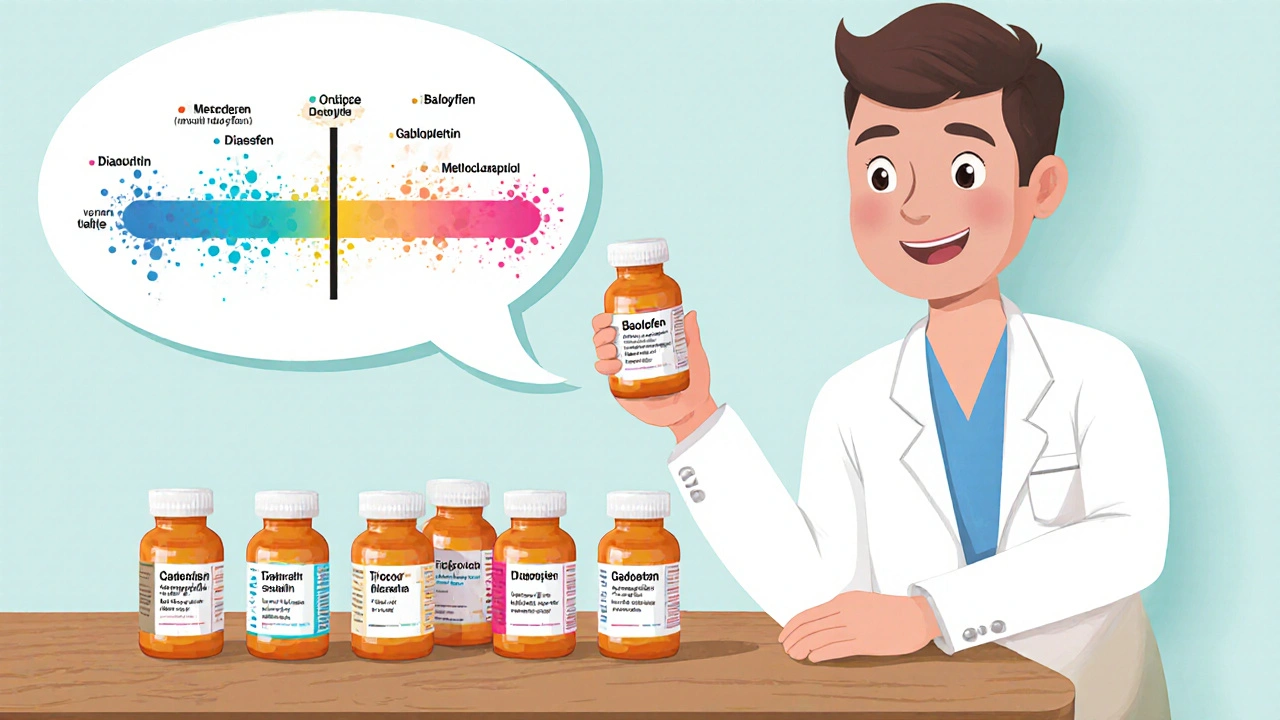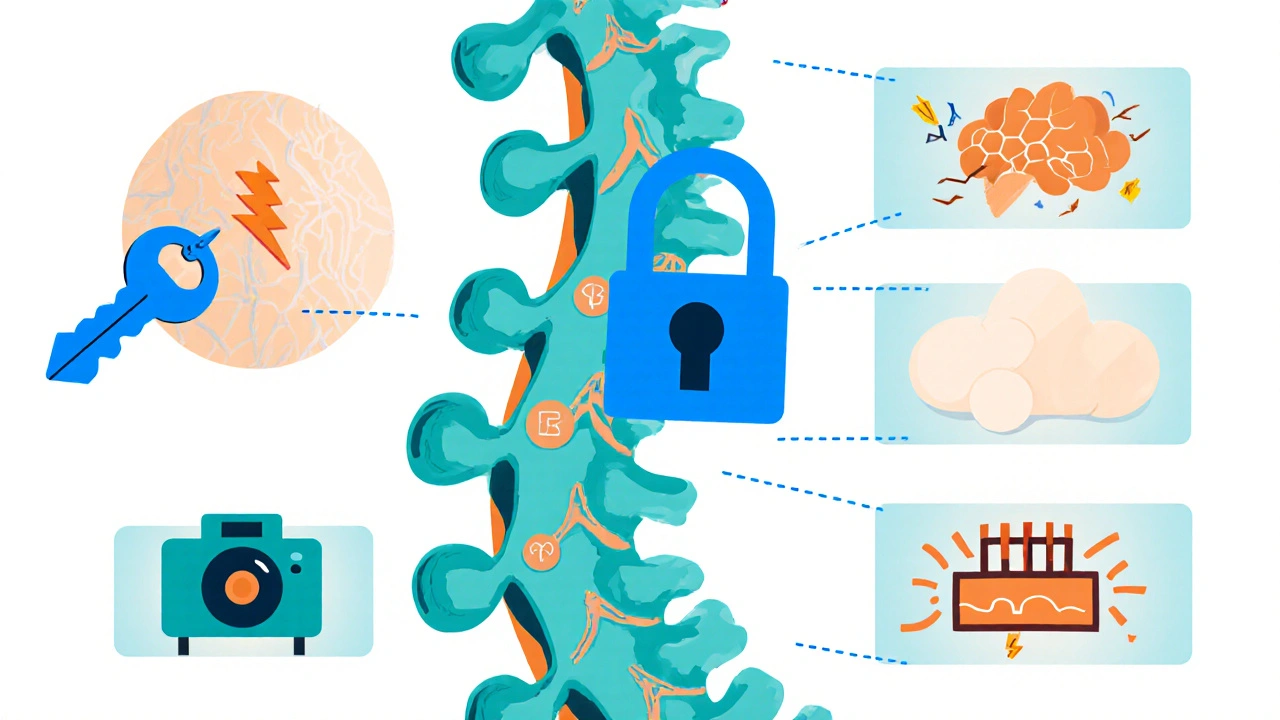Baclofen vs Alternatives: A Practical Comparison Guide
 Oct, 24 2025
Oct, 24 2025
Muscle Relaxant Selection Tool
Your Situation
Results
Why compare Baclofen with its peers?
When doctors prescribe a muscle relaxant for spasticity or painful muscle spasms, they often start with Baclofen. But it’s not a one‑size‑fits‑all solution. Different people react to the drug in unique ways, and costs, side‑effects, or dosing schedules can swing the decision toward another option. This guide walks you through the most common alternatives, so you can see how they stack up on the factors that really matter.
What is Baclofen?
Baclofen is a synthetic derivative of the neurotransmitter GABA that acts as a central nervous system depressant, primarily used to reduce muscle spasticity. It’s typically prescribed for conditions like multiple sclerosis, spinal cord injury, or cerebral palsy. The usual oral dose starts at 5 mg three times a day and may climb to 80 mg daily, split across doses. While many patients find relief, the drug can cause drowsiness, dizziness, or even abrupt withdrawal if stopped suddenly.
How does Baclofen work?
Baclofen binds to GABA‑B receptors in the spinal cord, dampening the nerve signals that cause muscles to tighten. Think of it as turning down the volume on a faulty speaker - the signal is still there, just softer. Because its action is central (in the brain and spinal cord), it can affect both upper‑ and lower‑limb spasticity.

Key criteria for a fair comparison
Before we jump into the side‑by‑side table, it helps to agree on the yardsticks:
- Efficacy: How well does the drug reduce spasm frequency and intensity?
- Onset of relief: Minutes, hours, or days?
- Side‑effect profile: Sedation, weakness, liver impact, etc.
- Dosing convenience: Number of pills, need for titration, or injectable forms.
- Cost & insurance coverage: Out‑of‑pocket expense in 2025.
These factors often decide whether a patient sticks with Baclofen or switches to a Baclofen alternatives that feels better for their lifestyle.
Quick side‑by‑side comparison
| Drug | Primary Use | Typical Dose | Onset | Common Side‑effects | Cost (US$ per month) |
|---|---|---|---|---|---|
| Baclofen | Spasticity | 5-80 mg/day PO | Hours | Drowsiness, weakness, withdrawal risk | ≈ $30‑$45 |
| Tizanidine | Spasticity, acute muscle spasm | 2-8 mg PO q8h | 30‑60 min | Dry mouth, hypotension, liver enzymes rise | ≈ $40‑$60 |
| Diazepam | Muscle spasm, anxiety | 2-10 mg PO q6‑8h | 15‑30 min | Sedation, dependence, respiratory depression | ≈ $12‑$20 |
| Gabapentin | Neuropathic pain, spasticity adjunct | 300‑1800 mg PO TID | 2‑3 h | Ataxia, edema, weight gain | ≈ $25‑$35 |
| Methocarbamol | Acute musculoskeletal spasm | 750 mg PO q6‑8h | 45‑60 min | Drowsiness, dizziness, GI upset | ≈ $15‑$25 |
| Cyclobenzaprine | Short‑term musculoskeletal spasm | 5-10 mg PO q8‑12h | 30‑60 min | Anticholinergic effects, drowsiness | ≈ $20‑$30 |
Diving deeper into each alternative
Tizanidine (Zanaflex) is a centrally acting α‑2 adrenergic agonist. It works by reducing excitatory neurotransmission, which leads to quicker muscle relaxation than Baclofen for many patients. Because it can cause a sudden drop in blood pressure, doctors often start at 2 mg and monitor liver enzymes regularly.
Diazepam belongs to the benzodiazepine family. Its fast onset makes it handy for acute spasms, but the downside is a higher risk of dependence and sedation, especially in older adults. It’s also cheaper, which appeals to patients on a tight budget.
Gabapentin was originally an anti‑seizure drug. For spasticity, it’s used as an adjunct because it modulates calcium channels, indirectly reducing muscle over‑activity. The trade‑off is the need for multiple daily doses and some weight gain.
Methocarbamol is a muscle relaxant with a relatively mild mechanism; it mainly depresses the central nervous system without directly acting on muscle fibers. It’s popular after orthopedic surgery where rapid, short‑term relief is needed.
Cyclobenzaprine is chemically similar to tricyclic antidepressants, giving it anticholinergic side‑effects like dry mouth and constipation. It’s only recommended for a few weeks because tolerance can develop quickly.
How to pick the right option for you
Think of the decision as a checklist you run with your clinician:
- Severity & chronicity: For long‑term spasticity, Baclofen or Tizanidine are usually first‑line. For a one‑off injury, Methocarbamol or Cyclobenzaprine may be enough.
- Side‑effect tolerance: If you’re sensitive to drowsiness, avoid Diazepam and consider low‑dose Tizanidine.
- Other health conditions: Liver disease makes Tizanidine risky; heart issues raise concerns about Diazepam‑induced hypotension.
- Cost & insurance: Generic Baclofen and Diazepam are often covered, while brand‑only Tizanidine can be pricier.
- Convenience: Fewer pills per day (Baclofen, Diazepam) vs multiple doses (Gabapentin).
Discuss each point with your provider; a tailored plan often involves trial periods to see which drug gives you the best balance.
Common pitfalls and safety tips
- Never stop Baclofen abruptly - taper over weeks to avoid seizures or high‑grade spasticity.
- Monitor liver function tests when using Tizanidine or high‑dose Gabapentin.
- Avoid mixing benzodiazepines (Diazepam) with alcohol or other depressants.
- Watch for signs of urinary retention, especially with high‑dose cyclobenzaprine.
- Keep a medication diary: note dose, timing, relief level, and side‑effects. It helps the doctor fine‑tune the regimen.
Bottom line
There’s no universal “best” drug for muscle spasm control. Baclofen remains a solid first‑line choice for chronic spasticity, but Baclofen alternatives like Tizanidine, Diazepam, Gabapentin, Methocarbamol, and Cyclobenzaprine each bring unique strengths. By weighing efficacy, side‑effect risk, dosing convenience, and cost, you and your clinician can land on the option that fits your daily life.
Can I use Baclofen for back pain?
Baclofen is approved for spasticity, not typical mechanical back pain. Some doctors prescribe it off‑label for muscle tightness around the spine, but it’s usually not the first choice. Talk to your doctor about safer options like NSAIDs or physical therapy first.
What is the fastest‑acting muscle relaxant?
Diazepam and Tizanidine have the quickest onset-often within 15‑30 minutes for Diazepam and 30‑60 minutes for Tizanidine-making them useful for acute spasms.
Is it safe to combine Baclofen with other muscle relaxants?
Combining central‑acting relaxants can amplify sedation, respiratory depression, and dizziness. Doctors usually avoid stacking Baclofen with Diazepam or Tizanidine unless there’s a compelling reason and close monitoring.
How long does it take to see improvement with Baclofen?
Most patients notice a reduction in spasm intensity within a few days of reaching a therapeutic dose, but full benefit can take several weeks as the dosage is titrated.
Are there natural alternatives to Baclofen?
Physical therapy, stretching routines, and yoga can improve muscle tone without medication. Some patients also explore magnesium supplements or acupuncture, but these should complement-not replace-prescribed treatment.

Olivia Harrison
October 24, 2025 AT 19:51Hey folks, just wanted to share a few practical tips that might help you navigate the Baclofen maze. First, keep a simple medication diary – jot down the dose, time, how you feel, and any side‑effects. Over time you’ll see patterns that can guide your doctor in fine‑tuning the regimen. Second, talk openly with your healthcare team about any drowsiness; sometimes adjusting the timing of the dose can keep you alert during the day. Third, if you notice withdrawal symptoms when missing a dose, never stop abruptly – taper slowly under supervision. Fourth, consider pairing the drug with gentle stretching or yoga; muscle tone often improves with movement. Fifth, stay on top of liver function tests if you’re on Tizanidine or high‑dose Gabapentin – early detection is key. Sixth, explore cost‑saving options like manufacturer coupons or pharmacy discount cards; it can make a big difference. Seventh, if you’re prone to constipation, add fiber and hydration to your routine. Eighth, watch for interactions with alcohol or other depressants – safety first. Ninth, involve a family member or friend in the medication routine to avoid missed doses. Tenth, ask about a slow‑release formulation if daily pill burden feels heavy. Eleventh, remember that every body is unique; what works for a neighbor might not work for you. Twelfth, keep an eye on blood pressure if you’re using Tizanidine – low readings can cause dizziness. Thirteenth, if you feel a new muscle weakness, report it promptly – dose adjustment may be needed. Fourteenth, leverage online patient forums for shared experiences, but verify information with a professional. Finally, stay patient; finding the right balance often takes weeks of trial and careful monitoring.
Bianca Larasati
October 30, 2025 AT 23:16Whoa, this guide is like a backstage pass to the muscle‑relaxant concert!
ram kumar
November 6, 2025 AT 02:42Honestly, this article feels like a laundry list of generic buzzwords masquerading as a guide, and the prose suggests the author scraped the internet for filler rather than offering any substantive insight.
Tamara Tioran-Harrison
November 12, 2025 AT 06:08While I appreciate the attempt at thoroughness, the pretentious drizzle of medical jargon merely obscures the glaring fact that most readers will still be left bewildered-perhaps a more succinct, reader‑centric approach would serve better. :)
kevin burton
November 18, 2025 AT 09:34For anyone juggling multiple meds, try setting alarms on your phone; it’s a simple trick that prevents missed doses and keeps your schedule consistent.
Max Lilleyman
November 24, 2025 AT 12:59Honestly, if you’re not tracking side‑effects, you’re basically gambling with your health 🙄💊.
Brett Witcher
November 30, 2025 AT 16:25The comparative table, while informative, could benefit from a clearer hierarchy of efficacy metrics; without such structure, the reader is left to infer importance subjectively, which may lead to suboptimal clinical decisions.
Benjamin Sequeira benavente
December 6, 2025 AT 19:51Listen up, if you’re not pushing yourself to discuss these options with your physician, you’re selling yourself short-demand a tailored plan and don’t settle for the first pill that’s handed to you!